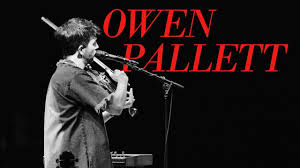 SOUNDTRACK: OWEN PALLETT–Live at Massey Hall (December 1, 2015).
SOUNDTRACK: OWEN PALLETT–Live at Massey Hall (December 1, 2015).
 Owen Pallett founded the band Final Fantasy (which was pretty much him anyhow). Since 2010 he has been recording under his own name. His music is orchestral and complex, but also distinctly weird. He loves to explore sounds, but he also knows how to throw in some catchy melodies as well.
Owen Pallett founded the band Final Fantasy (which was pretty much him anyhow). Since 2010 he has been recording under his own name. His music is orchestral and complex, but also distinctly weird. He loves to explore sounds, but he also knows how to throw in some catchy melodies as well.
He says he has played Massey Hall before but this is the first time as a solo performer. He wants to take advantage of the beautiful-sounding room and comfortable seats.
The songs he plays are a mix of new ones and Final Fantasy songs as well.
On “That’s When the Audience Died” (Final Fantasy), he picks out a complicated pizzicato on the violin and loops it (he mutters, I hope that worked) and then he launches a great melody over the top. He has a great singing voice as well. The lyrics are consistently clever and interesting. The end of the song is amazing with the sounds he ekes out of his violin.
He says he took violin lessons but wasn’t into it because the violin leaves a mark on your neck. He quit it because it ruined all his “sexual dreams,” and he switched to guitar and piano. He was always really into composing–he loved Béla Bartók and György Sándor Ligeti–he wanted to make music you’d see in a Stanley Kubrick film.
There’s beautiful looping with the pizzicato as he plays the solos live.
“This Lamb Sells Condos” (Final Fantasy) is really quite funny if you know the story behind it, which I didn’t. But here it is
This song is a comic interpretation of Brad J. Lamb, a figure in the Canadian real estate business (who used to live in the same building as Owen Pallett’s boyfriend), with allusions to elements of the Dungeons & Dragons role-playing game:
This snarky look at Lamb:
When he was a young man, he conjured up a firemare
Burnt off both his eyebrows and half a head of hair
And then as an apprentice, he took a drowish mistress
Who bestowed upon his youthfulness a sense of champagne chic
His seduction, his seduction to the world of construction
Now his mind will start to wander when he’s not at his computer
And his massive genitals refuse to cooperate
No amount of therapy can hope to save his marriage
Before he did Final Fantasy he played bad country music in bad country bars–because he had a violin.
“Tryst with Mephistopheles” rocks with a band (Matthew Smith and Robbie Gordon) and even some synths. The drums really propel the song forward.
When he created Final Fantasy he had a guitar, a violin, a bed and some books. He borrowed a looping pedal and got good with it. He wanted to be the best violin looper.
“The Riverbed” is with a string quartet and has a fast ripping opening melody–dark and very cool.
He says now that he’s making a record in which he’s not thinking about how to play it live. He’s just trying to make sounds–not thinking about performance or how to tour it.
So he’s playing new songs in traditional formal. He conducts the orchestra and sings “On a Path.” if t his is the “traditional format,” I’m very curious to hear what the non-traditional way is. It has a fantastic vocal melody and is incredibly catchy.
The final song is “This is the Dream of Win and Regine” (yes of Arcade Fire). It’s an older Final Fantasy song and has some great references to Montreal:
Montreal might eat its young, but Montreal wont break us.
There’s some great thumping beats throughout until the great dramatic ending.
Pallett had been on my radar, but I’m sold after seeing this show.
[READ: July 3, 2018] “The First World”
This story is bookended in an interesting way. It starts with the narrator saying that his marriage had come to an end. An unexpected consequence was that a series of men confided in him about their marriages past or present–not old friends, they stayed quiet, but people he’d had at arm’s length. A contractor, the dermatologist etc. People felt free to say wheat they wanted.
And then it was over, the men disappeared for about a decade during which time the narrator remarried. And then Arty resurfaced.
Arty ran into him on Ninth Avenue and insisted they grab a drink. He said there was something he’d like the narrator’s opinion on.
Arty had to talk about Gladys, the former nanny of his two girls. Gladys was is nanny for seven years, gave the girls all kinds of love and then left when the kids were old enough not to need her anymore. She got a new job in Chelsea for a younger child.
It was while working for this new family that Gladys lost her husband, Roy. He had died while in the hospital and they were billing her for one hundred and ten grand. She didn’t want to fight it because she was waiting for her green card.
Arty’s wife had cut off ties with Gladys (and didn’t want to talk to Arty either). Not long after the divorce, Gladys rang him up and asked for $500, explaining what had happened to Roy.
She had agreed to a payment plan for the $110,000, but times had been tough. She asked Arty for $500.
The bulk of the story is Arty’s impassioned telling of Gladys’ story. How everything seemed to go wrong for her. She moved back to Trinidad bit was not welcomed with opened arms. She tried to find work but was unable. And so regularly, she asked Arty for another loan, a loan that he knew he would never see.
She has even stayed with Arty when he pays for her ticket to visit her grown up son.
The narrator wants to get out of the conversation, but Arty has bought yet another round. The narrator has an amusing aside about how he lost his wallet and paid for his round with cash from his back pocket.
The story is bookended with the narrator returning home. The way the whole piece ends with him imagining his wallet being returned shows how differently two people can live and ponders what their attitudes have to do with it.







